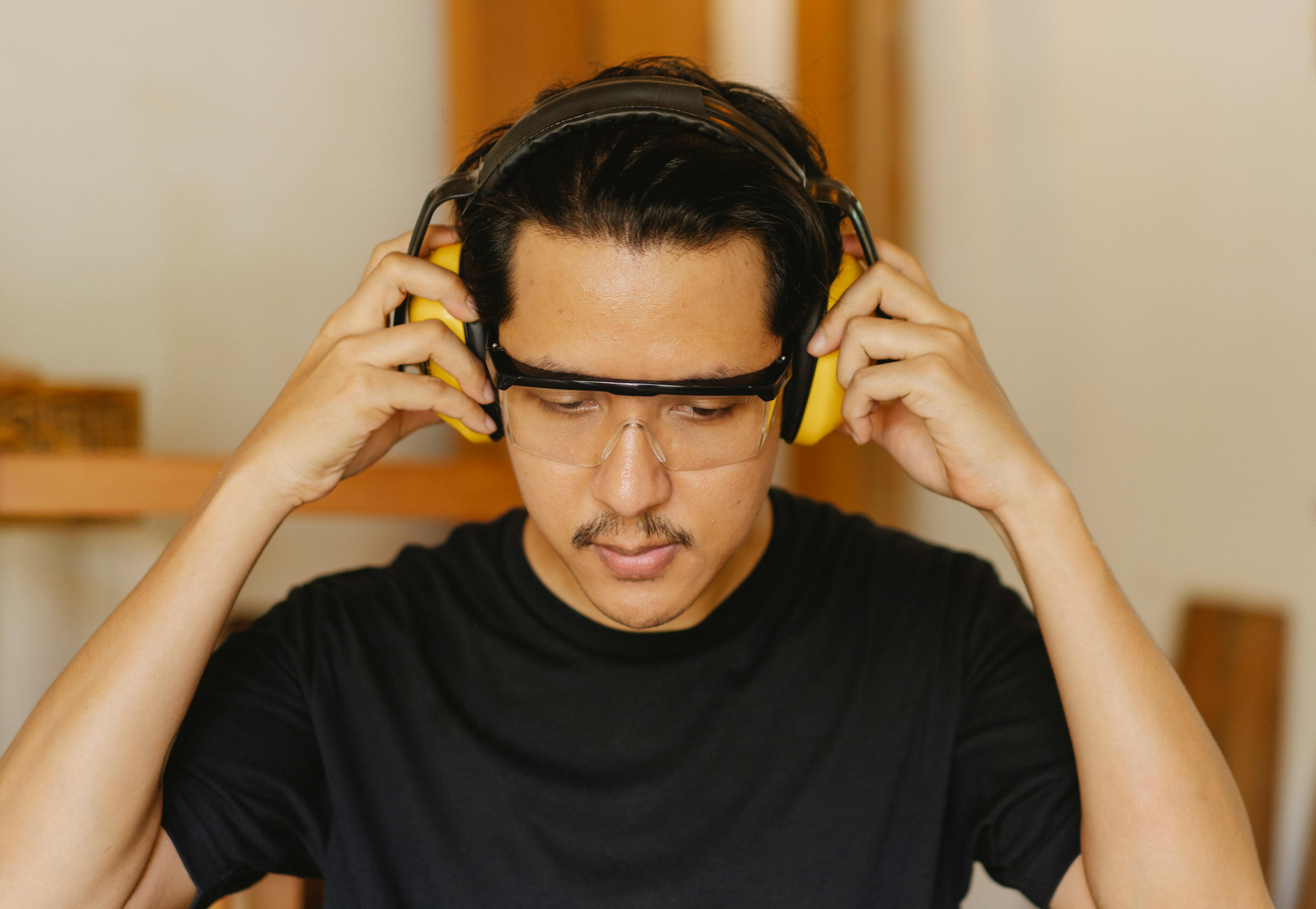How To Wear Headphones With Glasses

Headphones are a great way to listen to music and other audio, but if you wear glasses, it can be difficult to get the headphones to fit properly. Fortunately, there are a few simple steps you can take in order to make sure your headphones are comfortable and secure when you’re wearing glasses. In this guide, we’ll show you how to wear headphones with glasses so that you can enjoy your music or podcasts without any discomfort.Wearing headphones with glasses can be uncomfortable if not done correctly. Here are some tips to help you wear your headphones comfortably with glasses:
1. Make sure your headphones are not too tight when wearing them with glasses. Tightness can cause discomfort and create pressure points on the sides of your head.
2. Check that your glasses are not pressing against the earcups of the headphones. This can cause pain and discomfort during use.
3. Make sure your glasses fit properly on your face, with the arms of the frames sitting behind your ears rather than on top of them. This will prevent them from interfering with the fit of the headphones and reduce any discomfort caused by pressure points or movement.
4. Consider using over-ear headphones instead of earbuds, as they are typically more comfortable for use with glasses due to their larger size and more secure fit around the ears.
5. If possible, try different sizes or styles of headphones until you find a pair that is comfortable for you to wear with glasses for long periods of time.
Choosing the Right Type of Headphones for Glasses Wearers
Finding the right type of headphones for glasses wearers can be a challenge. With so many different types available, it can be hard to decide which ones are best suited to your needs. Fortunately, there are some factors that you should consider when selecting the right type of headphones for glasses wearers.
The first factor is comfort. Many glasses wearers have experienced discomfort when using traditional headphones due to the pressure on their ears caused by the earpieces. If this is an issue for you, then you should look for headphones that feature soft earpads and cushioned headbands that provide a snug fit without applying too much pressure on your ears and head.
The second factor to consider is sound quality. While most traditional headphones offer good sound quality, some newer models feature additional features that improve sound clarity and reduce background noise. This is especially important if you plan on using your headphones in noisy environments or while traveling on public transportation.
The third factor to consider is durability and longevity. When selecting headphones for glasses wearers, it’s important to choose models that are designed to last and won’t break easily due to regular wear and tear. Look for models made from durable materials such as metal or plastic, as these tend to be more resistant to damage than other materials such as cloth or leather.
Finally, it’s important to consider budget when choosing the right type of headphones for glasses wearers. While there are some high-end models available, these usually come with a hefty price tag. If you’re looking for something more affordable yet still offers good sound quality and comfort, then look for mid-range models from reputable brands such as Sony or Bose.
Adjusting Your Headphones for Better Comfort
Finding the right fit with your headphones is essential for comfortable listening. Headphones come in a variety of shapes and sizes, so it’s important to adjust them correctly to make sure you’re getting the best possible experience. Here are some tips on how to adjust your headphones for more comfortable listening:
• Start by adjusting the headband and ear cups. Make sure they fit snugly around your head and ears, but not so tight that they feel uncomfortable. You should also be able to easily slide the headband up and down.
• The ear cups should be angled slightly outward so that they fit comfortably over your ears. Make sure they are not too loose or too tight.
• If your headphones have adjustable ear pads, make sure they are adjusted correctly so that you can wear them comfortably for long periods of time. It’s also important to check if the ear pads are made from a material that won’t cause any irritation or discomfort.
• If you have wireless headphones, make sure you’re using the right size batteries or charging cable. This will help ensure that your headphones stay powered up for extended periods of time.
• Finally, if your headphones have an adjustable volume control, make sure it’s adjusted to a comfortable level before you start listening. This will help prevent any potential hearing damage from loud volumes.
By following these tips, you’ll be able to adjust your headphones for more comfortable listening sessions. Just remember to take regular breaks from wearing them and adjust them accordingly when needed!
1. Make Sure the Headphones Fit Comfortably
Finding the right fit for your headphones is essential for comfortable wear. Make sure the headphones fit snugly on your head without causing any discomfort. You should also ensure that the ear cups fit around your ears properly and that they are not pressing too hard against your glasses. If you find that the headphones are too tight or too loose, try adjusting them until you get a comfortable fit.
2. Try Wearing Your Glasses Over Your Headphones
If you’re having trouble wearing your glasses and headphones together, try wearing them both on top of your head. This will help to minimize any discomfort caused by having both of them on at the same time. It also gives you a bit of extra space between your glasses and the headphones so they won’t be pressed against each other.
3. Look for Headphones with Soft Cushions
When shopping for headphones, look for ones that have soft cushioning around the ear cups and headband area. This will help to ensure a comfortable fit and reduce any discomfort from having both of them on at once. Additionally, some headphone models may come with removable cushions so you can adjust them to give you a better fit if needed.
4. Wear Lightweight Glasses
If possible, wear lightweight glasses when using headphones as this will help to minimize any discomfort from having both of them on at once. Additionally, make sure that your glasses don’t have any sharp edges that could press against your skin or cause irritation when wearing them with headphones.
5. Use an Adjustable Headband
If possible, use an adjustable headband when wearing headphones with glasses so you can adjust it to get a comfortable fit without causing any discomfort or irritation to your ears or face. Additionally, adjustable headbands often come in various sizes so you can find one that fits properly without needing to make adjustments every time you put on the headset.
Utilizing Bluetooth or Wireless Technology
Bluetooth and wireless technology are becoming increasingly popular for a variety of applications. From connecting devices to sharing data, these technologies are becoming more prominent in the modern world. With the rise of mobile devices and internet connectivity, Bluetooth and wireless technology have become invaluable when it comes to transferring data quickly and efficiently.
When it comes to using these technologies, there are a few key considerations to keep in mind. First, security is paramount when dealing with sensitive data. It is important to ensure that any device using Bluetooth or wireless technology is protected from unauthorized access. Additionally, users should be aware of any potential interference that could disrupt the connection between devices.
Another important factor when utilizing Bluetooth or wireless technology is range. The distance a connection can be maintained depends on the specific technology being used, so it’s important to research the capabilities of each device before attempting to connect them over a long distance. It’s also important to consider battery life when using Bluetooth or wireless technology; as the connection runs continuously, battery usage can quickly add up if not monitored closely.
Finally, it’s important to consider compatibility when utilizing Bluetooth or wireless technology. Different devices may not be compatible with each other, so users should always check compatibility before attempting any connections or data transfers. Additionally, software updates may be required for certain devices in order for them to properly work with each other over a Bluetooth or wireless connection.
Overall, utilizing Bluetooth or wireless technology can provide many benefits in terms of convenience and efficiency when connecting multiple devices together or transferring data between them. However, it’s important to keep security, range, battery life and compatibility in mind when using these technologies in order to ensure smooth operation and reliable performance over time.

Taking Advantage of Over-Ear Headphone Designs
Over-ear headphones offer superior sound quality compared to their smaller, in-ear counterparts. They provide better noise isolation and can produce a wider range of sound frequencies. Additionally, the larger size of over-ear headphones allows for more advanced designs that can provide more comfort and better sound reproduction. By taking advantage of the larger size, manufacturers can create headphones that are more comfortable and provide better audio performance.
The first way to take advantage of the larger size is by using higher quality materials. Over-ear headphones can be made from materials such as leather or memory foam, which are more comfortable and offer better audio performance than other materials. Additionally, they can be designed with padded ear cups that distribute weight evenly across the head for improved comfort during long listening sessions.
The second way to take advantage of over-ear headphone design is to use larger drivers. Larger drivers produce a fuller sound with greater detail and clarity. Manufacturers often use multiple drivers in their designs in order to produce a wider range of sound frequencies and improve overall sound quality. Multi-driver designs also allow for improved bass response, which is especially important for genres such as hip hop or EDM where deep bass is essential.
Finally, manufacturers can take advantage of over-ear headphone design by including active noise cancelling technology. Active noise cancelling technology uses microphones to detect external sounds and then creates opposing signals that cancel out the unwanted noise. This technology not only improves audio performance but also ensures that listeners enjoy distraction-free listening experiences even in noisy environments like airplanes or busy city streets.
Overall, over-ear headphone designs offer superior audio performance compared to small in-ear headphones due to their larger size and higher quality materials used in construction. By taking advantage of these features, manufacturers are able to create headphones with improved comfort and sound quality that provides an immersive listening experience even in noisy environments.
Consider Adjusting Your Glasses for Added Comfort
Wearing glasses can be a great way to improve your vision, but if you’re not wearing them properly, you may be missing out on the full benefits. If your glasses are not fitted properly, they can cause discomfort and even headaches. To ensure that you’re getting the best out of your glasses, it’s important to consider adjusting them for added comfort.
The first step in adjusting your glasses is to make sure that they are sitting correctly on your face. Your frames should rest comfortably on the bridge of your nose and should sit evenly on both sides of your head. If you find that they are slipping off or causing any discomfort, then it may be time to adjust them.
Another thing to consider is the temples of your glasses. The temples should fit snugly behind your ears so that they won’t slip off or be too tight. If the temples feel too tight or if they are digging into the back of your ears, then it’s time to adjust them so that they fit better.
Finally, when adjusting your glasses, make sure that you don’t overtighten them as this can cause discomfort and even headaches over time. Instead, try adjusting them just enough so that they feel comfortable and secure without being too tight.
Adjusting your glasses for added comfort is an important part of keeping them in good condition and ensuring that you get the most out of them. With a few simple adjustments, you can make sure that you’re wearing your glasses correctly and comfortably every day!
Wearing In-Ear Headphones With Glasses Discreetly
Wearing in-ear headphones is a great way to enjoy your favorite music or audio content without disturbing those around you. However, if you wear glasses, the traditional earbuds can become uncomfortable and even painful. Fortunately, there are ways to wear in-ear headphones discreetly and comfortably with glasses.
One way to wear in-ear headphones with glasses is to use a pair of earhooks. These earhooks are designed to securely fit over the ears and attach to the headphone cord. This allows the headphone buds to rest comfortably behind the ears instead of on top of them, which can be much more comfortable when wearing glasses.
Another option is an over-the-head style headphone with an adjustable headband that fits snugly over your head and has cushioned earbuds that fit comfortably into the ears. This type of headphone is especially good for those who have larger heads or wear larger frames because it will stay in place and provide better sound quality than traditional earbuds.
Finally, if you want a more discreet look, you can opt for wireless Bluetooth headphones that sit on top of your head rather than inside your ears. These types of headphones have a longer battery life and provide excellent sound quality without being too visible. They also tend to be more comfortable than traditional earbuds when wearing glasses because they don’t press down on the ears as much as traditional buds do.
Overall, there are plenty of options available for those who want to enjoy their favorite tunes or audio content without sacrificing comfort or discretion while wearing their glasses. Whether you choose earhooks, over-the-head style headphones, or wireless Bluetooth headphones, you’ll be able to find something that works for you so that you can keep listening while looking stylish and comfortable!

Conclusion
Headphones can be a great way to listen to your favorite music or podcasts but if you wear glasses, it can be a challenge to find the most comfortable fit. The key is to find the right combination of frame size, headphone type and headphone size that fits comfortably on your head. Be sure to experiment and try out different combinations if necessary.
Also, make sure you’re using ear cushions that match the size of your ears and that the headphones don’t press too hard against the side of your head. If you follow these tips on how to wear headphones with glasses, you should have a much more comfortable listening experience.
